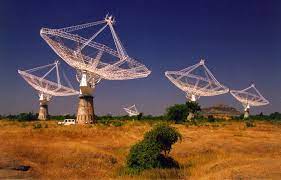Giant Metrewave Radio Telescope : Detected Atomic Hydrogen From a Far-Away Galaxy

A radio signal originating from atomic hydrogen in an extremely distant galaxy was detected by the Giant Metrewave Radio Telescope (GMRT).
- Astronomers from McGill University in Canada and the Indian Institute of Science (IISc) in Bengaluru have used data from the telescope to detect atomic hydrogen.
- Giant Metrewave Radio Telescope is a low-frequency radio telescope that helps investigate various radio astrophysical problems ranging from nearby solar systems to the edge of the observable universe.
- It is operated by the National Centre for Radio Astrophysics(NCRA), a part of the Tata Institute of Fundamental Research, Mumbai.
Atomic Hydrogen:
- Atomic hydrogen is the basic fuel required for star formation in a galaxy.
- When hot ionised gas from the surrounding medium of a galaxy falls onto the universe, the gas cools and forms atomic hydrogen.
- This atomic hydrogen then becomes molecular hydrogen and eventually leads to the formation of stars.
- Atomic hydrogen emits radio waves of 21 cm wavelength, which helps in the direct tracing of the atomic gas content in nearby and distant galaxies.




